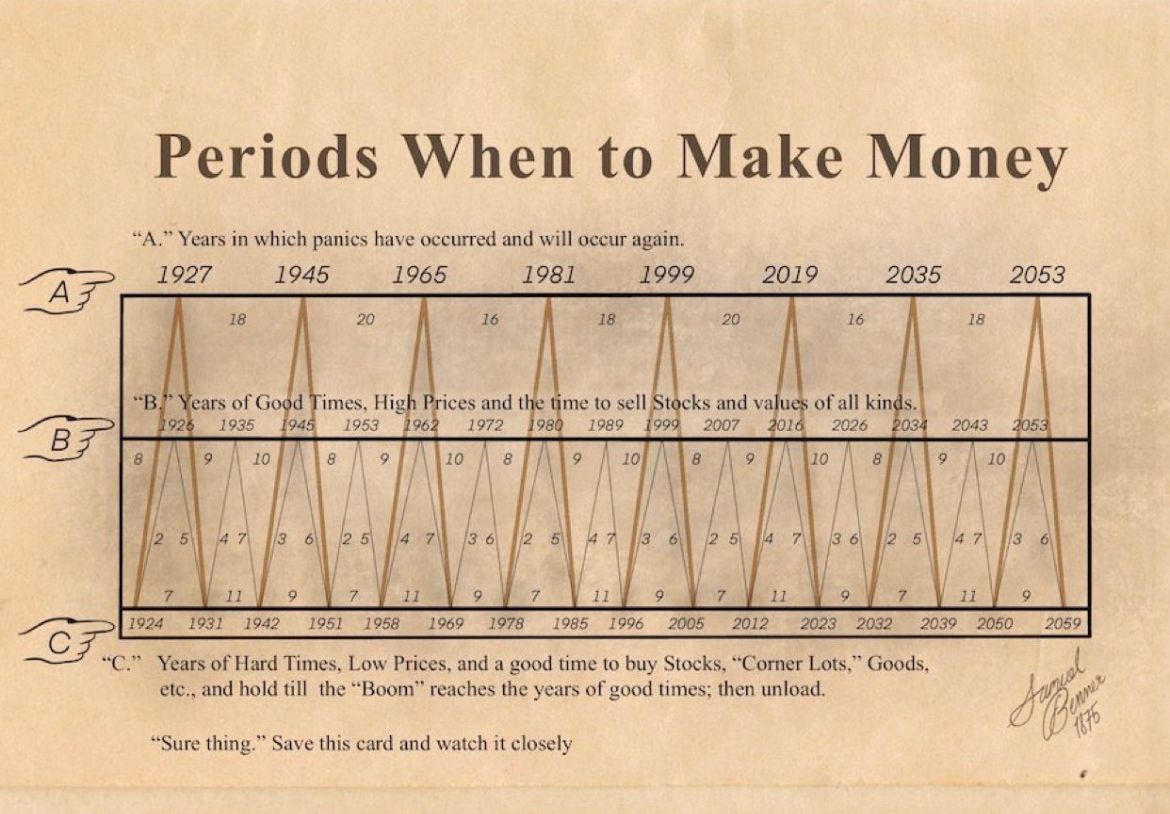Periods When to Make Money
Understanding financial market cycles can provide valuable insights. Market panics can offer investment opportunities, while prosperous periods may signal a time to sell. Recognizing these patterns helps make informed decisions, potentially improving investment outcomes.

A. Years in Which Panics Have Occurred and Will Occur Again
Financial markets can be as volatile and unpredictable as the weather, oscillating between periods of prosperity and periods of decline. One of the most severe forms of financial decline is a market panic, a sudden and often unanticipated drop in market values. Panics are typically accompanied by a rush of selling activity as investors scramble to liquidate their positions and minimize their losses.
Historically, market panics have been triggered by a variety of factors, including economic recessions, political instability, and catastrophic events. These periods of intense selling pressure often lead to significant losses for investors who are caught off guard. However, for those who are prepared and understand the cyclical nature of the markets, these periods can present unique investment opportunities.
The Nature and Causes of Market Panics
Market panics are generally characterized by widespread fear and uncertainty. This fear often becomes a self-fulfilling prophecy, as panicked selling leads to further price declines, which in turn fuels more panic and selling. The causes of market panics are complex and multifaceted, typically involving a combination of economic, political, and psychological factors.
Economic factors often play a critical role in triggering market panics. For example, a sudden rise in unemployment, a sharp contraction in GDP, or a sudden spike in inflation can all contribute to market instability. Political factors can also play a role, particularly in times of war or significant policy change.
Psychological factors are perhaps the most elusive and difficult to quantify, but they are also some of the most powerful drivers of market panic. Investor psychology can be influenced by a wide range of factors, from media coverage and social media chatter to the behavior of other investors. When fear and uncertainty take hold, rational decision-making often goes out the window, leading to panic selling.
Historical Market Panics
Throughout history, there have been numerous instances of market panics. The Great Depression of the 1930s, the Black Monday crash of 1987, the dot-com bust of the early 2000s, and the financial crisis of 2008 are just a few examples.
Each of these panics had unique triggers and unfolded in different ways, but they all shared common characteristics: rapid price declines, heightened volatility, and widespread investor fear. These periods were marked by significant financial loss for many investors, but they also presented opportunities for those who were prepared and able to take a longer-term perspective.
The Opportunity in Market Panics
Despite the fear and uncertainty that accompany market panics, they can also present unique investment opportunities. When panic selling leads to sharp price declines, assets that were previously overpriced can suddenly become bargains. For patient and disciplined investors, these periods can provide a chance to buy high-quality assets at significantly reduced prices.
However, investing during a market panic requires a clear understanding of the risks involved. While it's possible to find bargains during a panic, it's also possible to suffer significant losses if the market continues to decline. Therefore, a careful analysis of the market conditions and individual asset valuations is crucial.
B. Years of Good Times, High Prices and the Time to Sell Stocks and Values of All Kinds
While market panics are characterized by fear and selling, periods of prosperity in the financial markets are characterized by optimism and buying. These are the years of good times, when asset prices are high and the mood among investors is buoyant. During these periods, investors are often willing to# We hit the character limit in the previous message. The assistant should continue writing from where it left off.
Pay a premium for stocks and other assets, leading to high valuations and sometimes even asset bubbles.
The Nature of Prosperous Market Conditions
During prosperous market conditions, the economy is typically strong, with low unemployment, steady GDP growth, and stable inflation. This economic stability can contribute to investor confidence, leading to increased buying activity and rising asset prices.
In addition to economic factors, investor psychology can also play a significant role in driving prosperous market conditions. During these periods, investors often exhibit what is known as "herd behavior," where they follow the actions of the majority. If the majority of investors are buying, this can create a positive feedback loop, leading to even more buying and higher prices.
Historical Periods of Market Prosperity
Historically, periods of market prosperity have often been associated with periods of economic expansion. For example, the Roaring Twenties, the post-WWII boom, the 1990s tech boom, and the mid-2000s housing boom were all periods of significant economic growth and market prosperity.
During these periods, investor confidence was high, and asset prices rose rapidly. However, these periods of prosperity were often followed by periods of decline, as asset bubbles burst and investor sentiment shifted from optimism to fear.
Let's start by discussing the periods of financial panics, often characterized by economic recessions and depressions, sharp declines in asset values, and bank failures.
- The 19th Century: This century was marked by several periods of financial panic, starting with the Danish state bankruptcy of 1813, the Panic of 1819, 1825, 1837, 1847, 1857, 1866, 1873, 1884, 1890, 1893, and finally the Panic of 1896. These panics were usually followed by economic depressions and widespread financial instability, leading to low asset prices and potential opportunities for investment1.
- The 20th Century: Continuing into the 20th century, notable financial panics include the Panic of 1901 and 1907, the Depression of 1920–21, and the Wall Street Crash of 1929 that led to the Great Depression, the most severe depression in modern history. The latter part of the century witnessed the energy crisis of the 1970s, the Savings and Loan crisis in the U.S. during the 1980s, and several regional crises in the 1990s, such as the Asian financial crisis and the Argentine great depression1.
- The 21st Century: In the 21st century, significant financial crises include the dot-com bubble burst in 2000–2002, the financial crisis of 2007–2008, and the subsequent Great Recession, which was marked by a subprime mortgage crisis and a severe correction in the U.S. housing market1.
On the other hand, periods of economic prosperity, also known as booms, are characterized by substantial and widespread increases in economic activity that typically last several years. These periods are generally marked by high asset values, making them an ideal time to consider selling or divesting investments.
The Time to Sell
Recognizing the peak of a prosperous market period can be challenging. However, there are often signs that the market may be overheating. These can include excessively high asset valuations, overly optimistic investor sentiment, and an increase in speculative trading activity.
In these situations, it may be a good time to consider selling stocks and other assets. By selling when prices are high, investors can lock in their gains and avoid the potential losses that can occur when a market bubble bursts.
However, deciding when to sell is a complex decision that should be based on a thorough analysis of market conditions and individual financial goals. Selling too early can mean missing out on potential gains, while selling too late can result in significant losses.
In conclusion, understanding the cyclical nature of financial markets can provide valuable insights into when to buy and sell assets. By recognizing the signs of market panics and periods of prosperity, investors can make more informed decisions and potentially improve their investment outcomes. However, it's important to remember that investing always involves risk, and past performance is not a guarantee of future results. As such, it's crucial to conduct thorough research, stay informed, and consider seeking advice from a financial professional.

